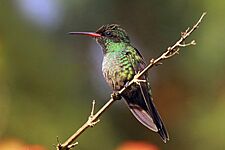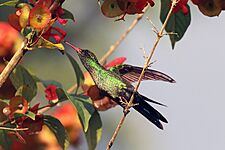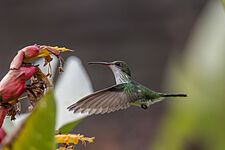Red-billed streamertail facts for kids
Quick facts for kids Red-billed streamertail |
|
|---|---|
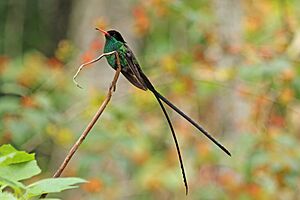 |
|
| Adult male | |
 |
|
| Female | |
| Conservation status | |
| Scientific classification | |
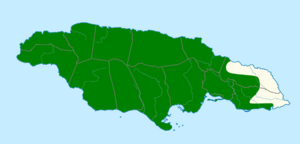 |
|
| Synonyms | |
|
Trochilus polytmus polytmus |
The red-billed streamertail (Trochilus polytmus) is a beautiful hummingbird found only in Jamaica. It's also known as the doctor bird or scissor-tail because of its long tail feathers. This special bird is the national bird of Jamaica!
Contents
About the Red-billed Streamertail
Naming and Discovery
The red-billed streamertail was first officially described in 1758. This was done by a Swedish scientist named Carl Linnaeus. He gave it the scientific name Trochilus polytmus.
There are two types of streamertails: the red-billed and the black-billed streamertail (T. scitulus). Some scientists think they are different species. Others believe they are just different types of the same species. They can even have babies together where their homes meet!
What Does It Look Like?
The male red-billed streamertail is quite long, about 22 to 25 centimeters (9 to 10 inches). This includes its amazing tail streamers, which can be 10 to 13 centimeters (4 to 5 inches) long! Males weigh between 4 and 6.5 grams.
The female is smaller, about 10.5 centimeters (4 inches) long. She weighs between 3 and 6.1 grams.
Male Streamertail
The adult male has a bright red beak with a black tip. Its head and neck are a deep, velvety black, forming a crest. The rest of its top parts are a shiny metallic green. Its tail is black and shimmers with green. The two longest tail feathers are what give it the "streamertail" name. The male's face and most of its belly are a metallic yellowish-green.
Female Streamertail
The adult female's beak is a duller red. Her top parts are a metallic bronze-green. She does not have the long tail streamers like the male. Her central tail feathers are bright bronze-green. The other tail feathers are black with white tips. Her belly is white with metallic bronze-green spots on her chest and sides.
Young males look like adult females but do not have the long tail streamers yet. Their tail feathers have bronze-green tips.
Where Does It Live?
The red-billed streamertail lives all over Jamaica. The only place it is not found is the far eastern part of the island. That's where the black-billed streamertail lives.
These birds like to live in different kinds of forests. This includes mountain forests, lowland forests, and forests that have grown back after being cut down. They do not like mangrove swamps or dry, high places. You can find them from sea level up to about 1,500 meters (4,900 feet) high. They are common in low areas and very common in middle and higher places.
Red-billed Streamertail Behavior
Movement
The red-billed streamertail is a bird that moves between different elevations. This means it travels up and down mountains depending on the season or food availability.
What Do They Eat?
Red-billed streamertails mostly eat nectar from flowers. They visit many different kinds of native and introduced flowers. They really like a plant called Besleria lutea. They can find nectar from flowers at any height, from the ground to the tops of trees.
They also eat small insects. They catch these insects while flying or pick them off leaves and spiderwebs. Sometimes, they even "steal" nectar from holes in flowers. These holes are made by other birds like bananaquits. They also visit sap wells drilled by yellow-bellied sapsuckers.
Reproduction and Life Cycle
Both male and female red-billed streamertails protect their feeding areas. Males try to attract females that come into their space. Both birds will perch and nod their heads. Then, the male flies up and down in front of the female, showing off his long tail streamers.
These birds can breed at any time of the year. However, they mostly breed between January and May. A pair might raise three groups of babies in one year!
Nests and Young
The nest is shaped like a cup. It is made of fine plant fibers held together with spiderwebs. The outside of the nest is covered with lichen. Nests are usually built on a thin branch. They are typically about 1 to 3 meters (3 to 10 feet) above the ground.
The female bird sits on her two eggs for 17 to 19 days. The baby birds leave the nest 19 to 24 days after they hatch.
Sounds and Calls
The red-billed streamertail makes several sounds. Its calls include a loud, metallic "ting" or "teet." It also makes a longer "twink-twink-twink" sound that gets lower in pitch at the end.
Adult males make a special whirring sound when they fly. This sound happens with each wingbeat. Videos show that a specific feather on their wing bends. This creates a gap that makes the fluttering sound.
Conservation Status
The IUCN (International Union for Conservation of Nature) has said that the red-billed streamertail is a species of "Least Concern." This means they are not currently worried about it becoming endangered.
The bird lives in a very large area. We don't know exactly how many there are or if their numbers are changing. However, there are no immediate threats to them. These birds can live in places changed by humans. This means losing their natural homes is probably not a big problem for them.
Gallery



